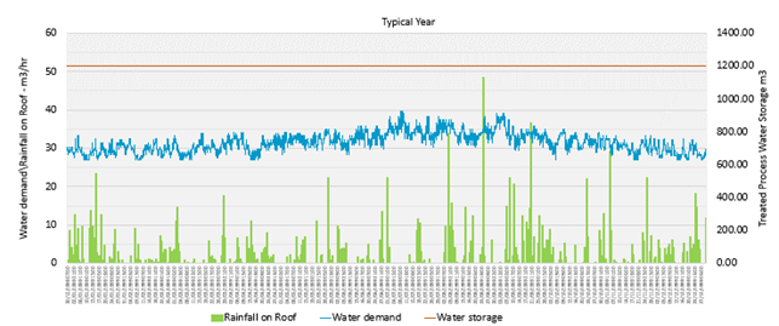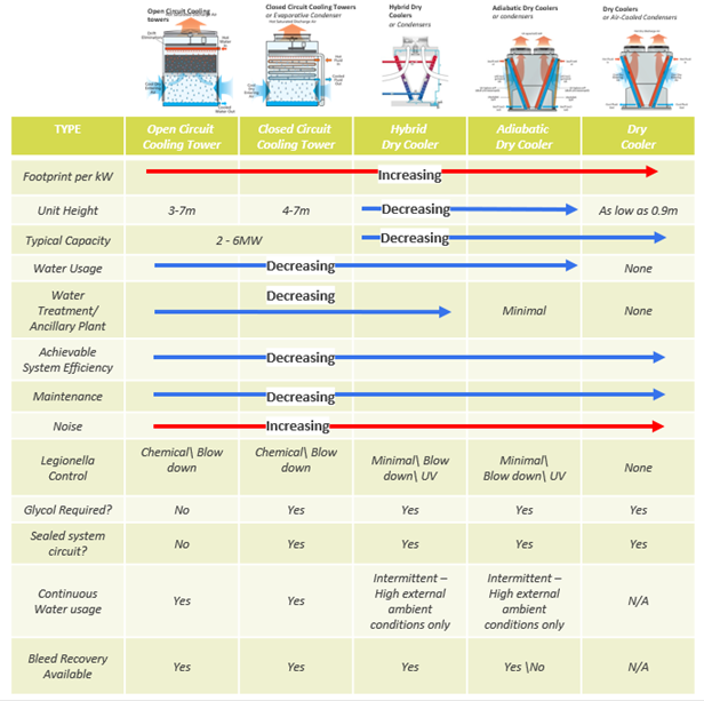
16 Jan 2024
10 minutes to read
Optimising Data Centre Efficiency: A Comprehensive Guide to Sustainable Design
Our first article on optimising data centre efficiency discusses water usage in Data Centres. Where water for evaporative cooling has been widely used for the last 10-15 years to drive efficiency, its is now under increasing levels of scrutiny.
Digital infrastructure and data centres (DCs) play important roles in modern society. Their impact on the environment has been gaining more attention from governments and communities. Significant progress has been made in the last 10 years to improve Power Usage Effectiveness (PUE) and energy efficiency of DC cooling systems. Some of these efficiency gains have been achieved by using more energy efficient systems reliant on evaporative cooling as an alternative to more widely used refrigeration based air cooled chillers . Energy efficiency gains and improvement in PUE has come at the expense of high water consumption and is contributing to water stress on supplies. DC water use and the Water Usage Effectiveness (WUE) is one of the main efficiency metrics used to measure a DC’s sustainability along with PUE and Carbon Usage Effectiveness (CUE) . The DC water use has created resistance from local authorities and communities regarding the extension of existing or construction of new DCs in certain areas globally. DCs can be seen as a burden on water resources, especially in areas with scarce water resources. These concerns have resulted in new water supply restrictions or regulations on building new DCs such as in Ireland [1], Netherlands [2], Scandinavia and elsewhere in EMEA. DC water use is generally becoming more of a concern and issue.
New regulations regarding the environmental impacts of DCs is forcing designers and operators of DCs to look into alternative technologies to minimise their water consumption. As an example, the recent trend in using hybrid coolers over cooling towers which are known to be more water efficient for DC heat rejection (Figure 4). Investment in water replenishment projects and minimising water consumption in cooling systems of DCs are becoming popular in corporate water stewardship strategies. Big IT companies like Microsoft and Google are committed to becoming water positive by 2030 meaning they replenish more water than they consume by the end of this decade [3] [4].
Rainwater harvesting (RWH)
Capturing and treating rainwater to utilise as process water in DCs is gaining more attention, especially in locations with moderate to high annual rainfall and locations where there are some restrictions being imposed by Water Utilities. The available roof area for collection of water, required storage capacity and water treatment equipment on the site are the main design considerations for utilisation of rainwater in data centres. As a general rule, less frequent, or longer periods between water demand, the more RWH storage is required and the greater RWH potential to satisfy the DC process water use. Examples of such application is Indirect evaporative cooling (IEC) for DCs. In a temperate climate like Dublin when water usage is intermittent and limited to summer time, RWH system could potentially provide up to ~80% of an IECs typical year’s process water demand (Figure 1), or for some direct air systems 100% of the cooling water demand. Whereas for cooling towers which rely 100% on water for heat transfer all year around, RWH only provides up to 1-2% of the makeup water demand (Figure 2). A RWH system serving cooling towers would require minimal additional water treatment and no additional storage. This is because rainwater intensities and corresponding maximum rate of RWH is likely to be much less than the cooling tower process water demand, so although a slight benefit this comes at relatively low capex.

Figure 1: Rainfall on roof vs IEC water demand and storage for a typical year

Figure 2: Rainfall on roof vs Cooling tower water demand for a typical year
Bleed Water Recovery (BWR)
DCs that use evaporative cooling with recirculatory water systems and their associated bleed waste water can be treated and reused as the evaporative cooling supply process water makeup. The reverse
osmosis (RO) process is typically used for recovery of bleed waste water. Dependent on the initial utility water supply, water quality and the water quality limits of the evaporative cooling systems, bleed water recovery saving can vary. Typically BWR can provide around 25% saving for operating at cycles of concentration (CoC) of 3. This saving is equivalent to operating at a CoC of 9 without BWR (Table 1). The limiting factor is maintaining the water quality to control scale formation, fouling and microbiological control and corrosion of evaporative cooling systems.
|
Cycle of Concentration (CoC) |
Evaporation Rate (m3/day) |
Total Water Consumption per day (m3/day) |
Bleed Loss (without bleed recovery (m3/day) |
Total water consumption Reduction compared to CoC=3 (without Bleed recovery) |
Bleed Loss (with bleed recovery (m3/day) |
Total water consumption Reduction compared to CoC=3 (with Bleed recovery) |
|
3 |
502 |
753 |
251 |
0.00% |
63 |
25%* |
|
4 |
502 |
669 |
167 |
11.3% |
42 |
27.8% |
|
5 |
502 |
628 |
126 |
16.7% |
32 |
29.2% |
|
6 |
502 |
602 |
100 |
20.0% |
25 |
29.8% |
|
7 |
502 |
586 |
84 |
22.2% |
21 |
30.5% |
|
8 |
502 |
54 |
72 |
23.8% |
18 |
31% |
|
9 |
502 |
565 |
63 |
25.0% |
16 |
31.2% |
Table 1 Evaporation and bleed loss - CoC and water saving relative to CoC of 3 (Without/with BWR)

Figure 4: Overview of the heat rejection equipment on System performance, operation, water treatment & usage
Before the industry strays away from evaporative cooling systems, in the pursuit of zero water usage. In turn, offsetting the additional power usage from less effective ‘dry’ cooling systems by purchasing green power purchase agreements to negate the utility emissions. It is worth considering how these more efficient evaporative cooling technologies can be optimised to minimize water usage and use reclaimed or a sustainable water sources to support them. Evaporative cooling is one of the most energy efficient solutions that in many climates can support year around free cooling. Reducing infrastructure costs as well as the associated embodied carbon.
Our next article on the subject of water usage in DCs investigates sea and river water cooling solutions.
Bibliography
|
[1] |
P. Judge, “Politician asks Irish Water to clamp down on wasteful data centers,” datacenterdynamics, 22 07 2021. [Online]. Available: https://www.datacenterdynamics.com/en/news/politician-asks-irish-water-to-clamp-down-on-wasteful-data-centers/. [Accessed 17 10 2022]. |
|
[2] |
S. Moss, “Dutch province of Flevoland enforces temporary data center moratorium,” datacenterdynamics, 15 06 2021. [Online]. Available: https://www.datacenterdynamics.com/en/news/dutch-province-of-flevoland-enforces-temporary-data-center-moratorium/. [Accessed 17 10 2022]. |
|
[3] |
Google, “Environmental Report 2022,” Google, CA, USA, 2022. |
|
[4] |
Microsoft, “2021 Environmental Sustainability Report,” Microsoft, Seattle, US, 2022. |
Co-creators
- Tim Castle, Technical Director
- Esmail Saber, Senior R&D Engineer
Latest Insights
View all insights







